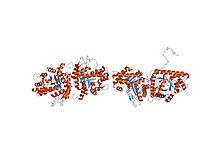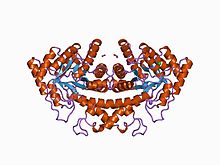Aldolases
Fructose-bisphosphate aldolase (EC 4.1.2.13), often just aldolase, is an enzyme catalyzing a reversible reaction that splits the aldol, fructose 1,6-bisphosphate, into the triose phosphates dihydroxyacetone phosphate (DHAP) and glyceraldehyde 3-phosphate (G3P). Aldolase can also produce DHAP from other (3S,4R)-ketose 1-phosphates such as fructose 1-phosphate and sedoheptulose 1,7-bisphosphate. Gluconeogenesis and the Calvin cycle, which are anabolic pathways, use the reverse reaction. Glycolysis, a catabolic pathway, uses the forward reaction. Aldolase is divided into two classes by mechanism.
The word aldolase also refers, more generally, to an enzyme that performs an aldol reaction (creating an aldol) or its reverse (cleaving an aldol), such as the one that forms sialic acid.
Class I proteins form a protonated Schiff base intermediate linking a highly conserved active site lysine with the DHAP carbonyl carbon. Additionally, tyrosine residues are crucial to this mechanism in acting as stabilizing hydrogen acceptors. Class II proteins use a different mechanism which polarizes the carbonyl group with a divalent cation like Zn2+. The Escherichia coli galactitol operon protein, gatY, and N-acetyl galactosamine operon protein, agaY, which are tagatose-bisphosphate aldolase, are homologs of class II fructose-bisphosphate aldolase. Two histidine residues in the first half of the sequence of these homologs have been shown to be involved in binding zinc.
...
Wikipedia


